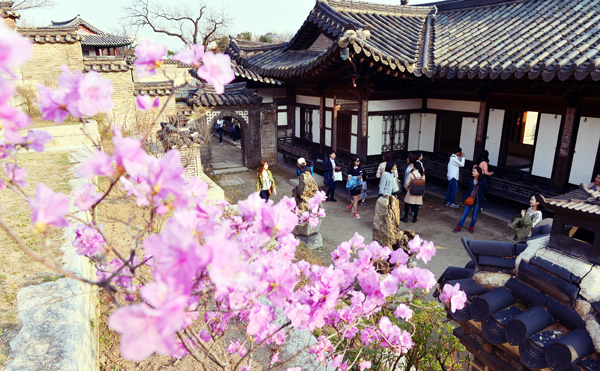Seoul’s old palaces open to the public more widely

A day view of the back of Nakseonjae, the complex behind Changdeok Palace, which has opened to the public for the first time. [NEWSIS]
On April 1, Changdeok Palace in central Seoul opened up the garden behind Nakseonjae, the complex of buildings made by King Heonjong in 1847 for his concubine. Aside from a few special events, the garden has never really been open to the public before, but the Cultural Heritage Administration decided to give visitors a chance to appreciate the flowers that grow there, including the apricot flowers.
In addition, two other palaces are set to begin their late-night extended hours. Starting April 29 for Changgyeong Palace and April 30 for Gyeongbok Palace, the Culture Heritage Administration will allow people to enjoy these ancient manors for 12 days in the evening from 7 p.m. to 10 p.m. (Visitors must enter the palaces before 9 p.m.)
It’s a program that has been offered in the spring and summer for five or six days at a time since 2010. But this year, the Cultural Heritage Administration, or CHA, is opening up the palaces four times for 12 days at a time.
In addition, the number of visitors allowed in each day will be raised during the spring and autumn seasons to 2,000 for Gyeongbok Palace and 2,200 for Changgyeong Palace, an increase of 500 for each.
In the summer and winter, the number of people allowed in will remain at 1,500 and 1,700, respectively.
“In the spring and fall, the royal palaces boast their most beautiful looks, especially in spring when the flowers are in full bloom,” said Kim Joong-tai, deputy director at the cultural administration.
“By increasing the number of people allowed in the palaces, we are aiming to provide visitors more opportunities to enjoy Korean traditional culture.”
In addition, the National Palace Museum of Korea, which is located inside Gyeongbok Palace, will also stay open late, allowing visitors to learn about the relics of the royal families of the Joseon Dynasty until 10 p.m. As usual, the museum is free.
However, allowing the public into these historical spaces in the evening requires resources. Last year, some visitors were caught drinking, littering and generally causing problems, so the CHA is planning to invite more volunteer workers to control the crowd.
In addition, despite having a limited number of spots open each evening, last year upward of 40,000 people flocked to Gyeongbok Palace, and the palace didn’t have enough officials to sell tickets or keep order.
So now the CHA is relying on having more volunteers inside and outside the palace to ensure safety and order, and to prevent individuals from trying to set up unlicensed vending booths inside.
Applications for volunteer spots are available on the two palaces’ official websites until April 21.
Alcoholic beverages and anything that creates fire will be strictly checked at the entrances.
Online tickets are available at ticket.auction.co.kr. Tickets for Gyeongbok Palace go on sale on April 23 at 2 p.m., and tickets for Changgyeong Palace will start selling on April 22 at 2 p.m.
Entrance to Gyeongbok Palace costs 3,000 won ($2.85), the same as the day rate. Changgyeong Palace costs 1,000 won. Individuals are limited to just two tickets each.
Gyeongbok Palace is closed on May 6 and Changgyeong Palace is closed on May 5.
BY JIN EUN-SOO, Lee Sun-min [estyle@joongang.co.kr]










with the Korea JoongAng Daily
To write comments, please log in to one of the accounts.
Standards Board Policy (0/250자)